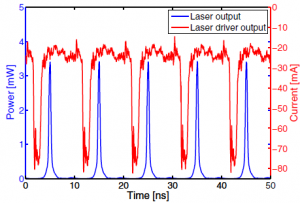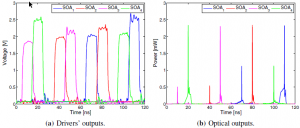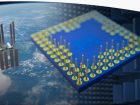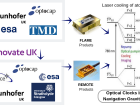Abstract: A novel integrated optical source capable of emitting faint pulses with different polarization states and with different intensity levels at 100 MHz has been developed. The source relies on a single laser diode followed by four semiconductor amplifiers and thin film polarizers, connected through a fiber network. The use of a single laser ensures high level indistiguishability in time and spectrum of the pulses with the four different polarizations and three different levels of intensity.
The applicability of the source is demonstrated in the lab through a free space quantum key distribution experiment which makes use of the decoy state protocol. A lower bound secure key rate of the order of 1.82 Mbps and a quantum bit error ratio as low as 1.14×10−2 and 93 bps for an equivalent attenuation of 35 dB were achieved.
To our knowledge, this is the fastest polarization encoded QKD system which has been reported so far. The performance, reduced size, low power consumption and the fact that the components used can be space qualified make the source particularly suitable for secure satellite communication.
The compact faint pulse source
Fig.1 Schematic of the QKDsource.[LD] denotes a laser diode,[C] a single-mode in-fiber 1×2 coupler, [SOA] a semiconductor optical amplifier, [P] a free-space thin-film polarizer and [BF] a single-mode bare fiber.
In order to use it for space applications, the proposed integrated FPS source consists of spacequalified discrete components (Figure 1): a single semiconductor laser diode emits a continuous
train of optical pulses at 100 MHz, equally split to four outputs using three in-fiber single-mode 1×2 couplers. Each fiber output is followed by an integrated (waveguide) SOA. The four bare
fibers to the coupling tube are accurately positioned on a custom opto-mechanical mount to simultaneously achieve the correct launching to the polarizers substrate sheet as well as to introduce a desired 70 dB coupling-loss to work in the single-photon regime at the end of the output bare fiber. Each polarizer is accurately oriented to produce one of four the four polarizations (0°, 90°,45°and −45°) required for BB84 protocol. Finally, the output fiber can be connected to the corresponding optical link interface (e.g. a telescope for free-space communication or optical fiber for terrestrial links).
Experimental measurements
 The train of optical pulses generated by the laser diode when driven by electrical pulses of 1 ns at 100 MHz. The resulting optical pulse duration is about 400 ps. Since all optical pulses are generated in the same way, by direct modulation of the laser diode, they can be assumed to be indistinguishable. Furthermore, the short optical pulse duration of 400 ps (small duty cycle) has the advantage of increasing the signal-to-noise ratio, since the measurement window (detection time) in the receiver side can be reduced.
The train of optical pulses generated by the laser diode when driven by electrical pulses of 1 ns at 100 MHz. The resulting optical pulse duration is about 400 ps. Since all optical pulses are generated in the same way, by direct modulation of the laser diode, they can be assumed to be indistinguishable. Furthermore, the short optical pulse duration of 400 ps (small duty cycle) has the advantage of increasing the signal-to-noise ratio, since the measurement window (detection time) in the receiver side can be reduced.
The pulses with different intensities required to implement the decoy state protocol are shown for all the four SOAs, together with the driving signals, loaded with a 50W resistance for monitoring purposes. Notice that the modulation time window of the driving signals is much larger (> 5 ns) than the optical pulse thus minimum  distortion is produced. A continuous periodic sequence, driving the four SOAs at the same time, is used to set the intensity level of a single SOA while the other three SOAs remaining in the OFF state. In particular, the three intensity levels correspond to: a high intensity level state which is set to 1/2 average photon per pulse by adjusting the coupling efficiency to the output bare fiber; then a second lower intensity level and the third level is set as vacuum (the SOA is not switched ON).
distortion is produced. A continuous periodic sequence, driving the four SOAs at the same time, is used to set the intensity level of a single SOA while the other three SOAs remaining in the OFF state. In particular, the three intensity levels correspond to: a high intensity level state which is set to 1/2 average photon per pulse by adjusting the coupling efficiency to the output bare fiber; then a second lower intensity level and the third level is set as vacuum (the SOA is not switched ON).
QKD free-space transmission
The free-space link was emulated in the laboratory by placing different neutral density attenuators along the propagation path from Alice (the source) to Bob (the receiver). We then measured the rates and performances of the QKD BB84+decoy state protocol using the presented source. In the implementation of the BB84 protocol, only single-photon pulses contribute to the secure key, while in the 3-state decoy state protocol the full range of intensities should be considered.
Conclusions
We have shown that a single photon source based on an attenuated laser diode for QKD applications can be built based on a novel scheme including semiconductor optical amplifiers. The source is capable of generating pulses of random polarization distributed over four states and three intensity levels required for BB84+decoy state protocol. A lower bound secure key rate of 1.82 Mbps with a quantum bit error ratio as low as 1.14×10−2 for an attenuation of 6 dB. To our knowledge, this is the fastest polarization encoded QKD system which has been reported so far. Given the relatively low driving voltages of the SOAs, the laser diode and the other integrated optical components, the proposed transmitter is potentially low power consumption, highly integrable and stable. The experimental demonstration has been carried out at 850 nm, for the implementation in free-space links, with 100 MHz generation rates . However, taking into consideration that the SOA’s bandwidth can go well beyond 10 GHz and operate also at other wavelengths (e.g. 1310 nm and 1550 nm for fiber transmission), the source can be easily scalable to higher bit rates, the upper limit probably being set by the laser diode itself.
- LED Technologies & Properties - 2nd February 2016
- Fast optical source for quantum key distribution based on semiconductor optical amplifiers - 1st February 2016
- Low Temperature Radiation Test of High Voltage Optocouplers for Space Applications - 1st February 2016



